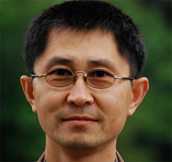 CUDA Spotlight: Yifeng Cui By Calisa Cole, posted July 3, 2013 GPU-Accelerated Earthquake SimulationsThis week's Spotlight is on Yifeng Cui, director of the High Performance GeoComputing Lab (HPGeoC) at the San Diego Supercomputer Center (and adjunct professor in the Dept. of Geological Sciences at San Diego State University). HPGeoC was recently named a winner of the HPC Innovation Excellence Award by IDC for developing a highly-scalable computer code that promises to dramatically cut research times and energy costs in simulating seismic hazards. Also contributing to the code’s development were Jun Zhou and Efecan Poyraz, graduate students of Electrical and Computer Engineering (ECE) with the Jacobs School of Engineering at UC San Diego; and Dong Ju Choi, a computational scientist at SDSC. This interview is part of the CUDA Spotlight Series. Q & A with Yifeng CuiNVIDIA: Yifeng, what are the key technology challenges in your field? Producing realistic seismograms at high frequencies relevant to building engineering design, up to 10 hertz, will require a major increase in supercomputing power with exascale hardware capabilities. Moreover, to realistically calculate seismic hazards across huge expanses of California and other tectonically active regions requires more than just a few earthquake simulations. Toward that end, the Southern California Earthquake Center (SCEC), a consortium of earthquake researchers from more than 60 universities and other institutions funded by NSF and USGS, has embarked on an ambitious effort called CyberShake with a goal of performing physics-based, probabilistic seismic hazard analyses to better inform engineers and planners about constructing and retrofitting buildings to reduce seismic risk, increase community resilience, and save lives. To put this problem into perspective, a California state-wide seismic hazard map at the maximum frequency of 1 hertz would require intensive ground shaking calculations at a few thousand sites. Thus, to advance and apply earthquake system science research within the practical limits of currently available HPC resources, we must aggressively improve the computational performance of our physics-based ground motion simulation software. NVIDIA: How are GPUs helping you solve these challenges? NVIDIA: What specific approaches do you use to apply GPU computing to your work? CUDA asynchronous memory copy operations help effective overlap of CPU/PCIe data transfer with GPU computation. A two-layer scalable IO technique was developed to efficiently handle many terabytes of dynamic source and media inputs, as well as 3D volume velocity outputs. We are also tuning co-scheduling to allow full utilization of both CPUs and GPUs in the hybrid heterogeneous systems. We are grateful for NVIDIA’s support during our implementation process.
NVIDIA: Tell us about your use of the Titan system at Oak Ridge National Lab. NVIDIA: How did you get interested in this field? NVIDIA: When did you first think of applying GPUs to earthquake simulations? NVIDIA: What advice would you offer other seismologists looking at using CUDA? Bio for Dr. Yifeng CuiYifeng Cui is a computational scientist at SDSC and an adjunct professor at SDSU, a lead of the Computational Science Committee of the Southern California Earthquake Center. He holds a Ph.D. in hydrology from University of Freiburg, Germany. Dr. Cui’s earthquake research efforts were honored with the 2009/2011 SciDAC OASCR awards and a 2010 ACM Gordon Bell finalist. In 2013, his HPGeoC Lab was named a winner of IDC's HPC Innovation Excellence Award. He has lived in four countries and speaks three languages. In his spare time, he enjoys hiking and biking. Relevant Links Contact Info |